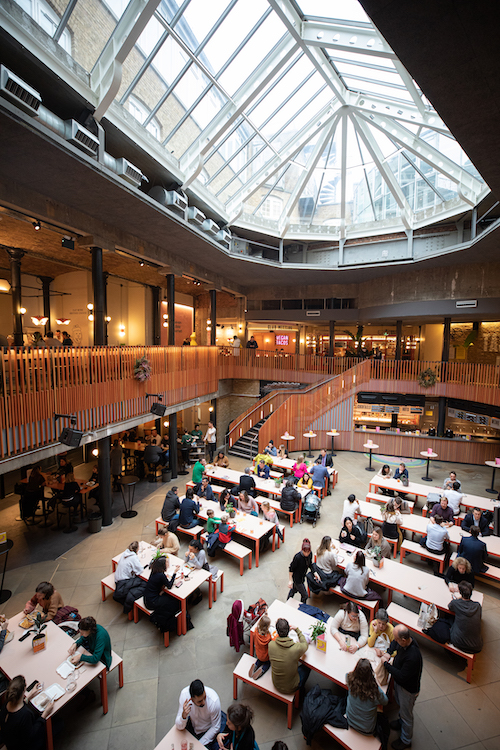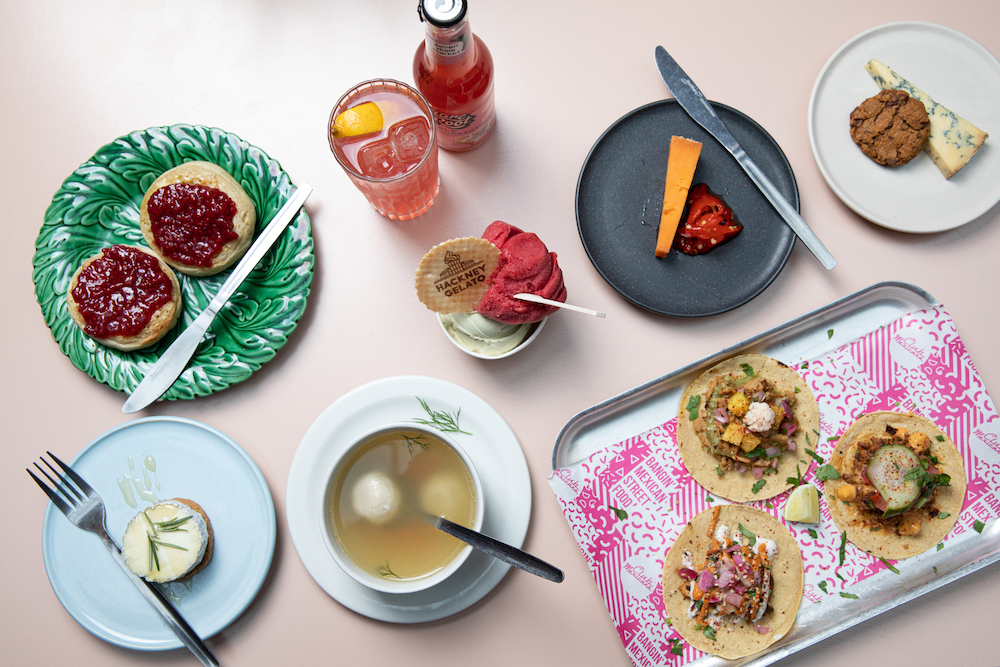London’s allure as a food capital lies in its diversity in food, and there’s no place better than a food hall to get a taste of its rich flavours under one roof
It’s 12.35pm on Thursday in central London, and at Market Hall West End – a gargantuan new food hall off Oxford Circus – the trickle of customers is fast becoming a flood.
Up the escalator, past the neon sign that says “Stairway to Food Heaven”, people flow – a boisterous mix of office workers, holiday shoppers, tourists and food obsessives united by the singular desire for a tasty, relatively inexpensive lunch in a communal setting. As the crowd fans out across this massive, stripped-back space that was once a department store, about a dozen different food outlets scramble to meet the lunchtime rush. They serve everything from tacos to rotisserie chicken, ravioli to roti canai.

With so much to choose from, indecisive diners – myself among them – are prone to experiencing momentary paralysis. Should we go the vegan route and order pad thai with tofu puffs from Cookdaily? Or pop around the corner to Hotbox for a burger made with a 28-day dry-aged beef patty topped with melted American cheese?
Eventually, after much agonising, I decide on these two: a chicken katsu curry sando (sandwich) from Yatai, served with exquisite pickles and a Japanese curry sauce, followed by an intensely delicious crab spaghetti with chilli and bottarga (cured fish roe) from Pastaio.

Being able to globetrot like this within a single meal, under one roof, is still quite a novelty in London. Until recently, a food hall to a British person meant the section of a department store where food and drinks are sold.
You could find an array of dining options in one place at street food markets too, which have become popular over the past decade, but these tend to be situated outdoors or in temporary indoor venues.
Market Hall West End is something new: A permanent indoor space, more luxurious and cohesive than its street food counterparts and more accessible. You can rock up here any day of the week before noon, contemplate menus indebted to China, Mexico or the Deep South and lounge around till closing time at midnight.
“Being able to globetrot
within a single meal,
under one roof, is quite
a novelty in London”
Sprawling across 3,252m² with seats for nearly a thousand diners over two floors, Market Hall West End is the biggest food hall in the UK – but it doesn’t lack for competition. In the past six months alone, three more food halls, each with a dizzying variety of options, have opened in prime locations – in Mayfair, New Oxford Street and Covent Garden.
They’ve added to a growing number of similar venues outside the city centre – and there are even more to come, with Eataly and Time Out planning to muscle in on the action within the next two years.

For a city that prides itself on being at the forefront of food trends, it’s curious how long this phenomenon has taken to materialise in London. “The growth of food halls has been really prolific across America,” says Simon Anderson, chief creative officer of Market Halls, which opened its first two sites in 2018, in Fulham and Victoria. “And, of course, this style of dining is really common across the whole of Asia, but culturally, it’s just something that wasn’t happening over here.”
So, what’s changed?
One key factor, according to Simon, is the decline of the high street. As online shopping becomes more prevalent, brick-and-mortar retailers have been scaling back or going out of business entirely, leaving a trail of empty real estate in their wake. The building now partly occupied by Market Hall West End used to belong to the department store chain BHS before it closed in 2016.

“Spaces are becoming available in prime locations,” says Petra Barran, founder of the street food organisation Kerb, which launched Seven Dials Market in September. “Five years ago, you might have been able to open a street food market in places like Dalston [a fashionable neighbourhood in east London], but due to competition for space and prohibitively high rents, central London was out of bounds.”
Seven Dials Market is set in an old banana warehouse in Covent Garden – a space which was, according to Petra, earmarked to become the latest outpost of a well-known fashion retailer before she and her company persuaded the landlord that a food hall would be a better bet.
If the hordes on a Friday evening are anything to go by, they have a point. Around 5.30pm, this airy, two-storey space switches from laid-back daytime mode – parents with buggies munching on steamed buns, freelancers on laptops sipping IPAs, reggae playing on the sound system – to post-work frenzy.
Down in the coral-pink basement, the communal seating fills up within minutes with a young, international crowd that swigs rum cocktails and debates over ordering crispy calamari from Ink or guava-glazed chicken wings from El Pollote.

The variety here is even greater than at Market Hall. The larger, café-style units upstairs include the Jewish deli Monty’s, beloved for its salt beef sandwiches; Club Mexicana, known for vegan tacos and burritos; and Pick & Cheese, which claims to have launched the world’s first cheese conveyor belt – where you grab plates of Cornish gouda and Basque-style burnt cheesecake as they whizz by underneath your nose.
The current popularity of food halls like Seven Dials Market can, according to Petra, be attributed to “a confluence of things”. “Dining culture in London has really loosened up over the last ten years,” she says. “Our living spaces have got smaller, so we’re eating out more. And we don’t want to commit ourselves in the same ways.”
“You can find almost
any type of food here,
cooked to a high standard
by people who really care
about what they’re doing”
Simon agrees that the versatility of food halls is a major selling point. “You can come on your own or in a group, and you can all choose your own food. You can bring your fussiest friend and be assured that they might find a vegan bite or an obscure dish. And then, at the end of the night, there won’t be a need to split the bill.”
Almost all of the traders at Seven Dials Market had their start in street food, but Market Hall chooses to draw primarily from established restaurants – as does Arcade Food Theatre, a glitzy operation on New Oxford Street. In this large, expensively fitted glass box of a space at the foot of the Centre Point tower, you’ll find distilled versions of popular restaurants such as Lina Stores, the Soho pasta specialist, and Pophams, a bakery noted for its imaginative pastries.

I make a beeline for Oklava. While the original restaurant in Shoreditch is hailed for its modern take on Turkish-Cypriot cuisine, the concession at Arcade focuses mainly on a single dish: the Black Sea pide, a sort of Turkish pizza enclosing a pool of molten cheese with a raw egg yolk on top. Every bit as indulgent as it sounds, with black garlic and za’atar (an aromatic spice blend) adding sweetness to the crust, the pide is probably the most satisfying dish I’ve encountered in my food hall adventures thus far.
These bustling, often chaotic establishments are not for everyone, or every occasion. If it’s intimacy you’re after, or the warmth of a waiter’s attention, you may want to stick to the traditional restaurant, of which this city has countless great examples.

But London’s particular strength as a food capital lies in its diversity: You can find almost any type of food here, from any part of the world, cooked to a high standard by people who really care about what they’re doing. And if you want to get a flavour of this diversity under one roof, a food hall is an excellent place to start.
Now excuse me while I work out what to eat next – the steak wrapped in Yorkshire pudding, or the lychee and tomato coconut ceviche? Or perhaps that piri-piri chicken with Portuguese fries…
Malaysia Airlines flies 14x weekly between Kuala Lumpur and London. To book a flight, visit malaysiaairlines.com.





